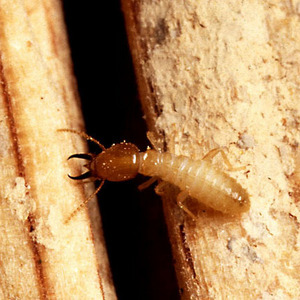Understanding termite digestion could help biofuels

USDA Agricultural Research Service
February 20, 2013
BY Purdue University
A termite's own biology with help from microorganisms called protists, are keys to the insect's digestion of woody material, according to a Purdue University scientist.
Michael Scharf, the O. Wayne Rollins/Orkin Endowed Chair in Urban Entomology, studies termite digestion to improve biofuels production and find better ways to control termites. The U.S. Department of Agriculture estimates the cost of controlling termites and repairing damaged homes is $2 billion each year in the United States.
Much of the study on how termites break down woody materials, which focused on the symbiotic relationship between the insect and the bacteria living in its gut, found that bacteria apparently have little, if anything, to do with termite digestion.
Scharf and collaborators at the University of Florida wanted to see how diet affected those bacteria. If the bacteria play a role in digestion, the type of materials the insect eats should affect the composition of the bacterial community living in the termite gut.
Advertisement
More than 4,500 different species of bacteria were cataloged in termite guts. When multiple colonies of termites were independently fed diets of wood or paper, however, those bacteria were unaffected.
"You would think diet would cause huge ecological shifts in bacterial communities, but it didn't. We didn't detect any statistical differences," Scharf said.
What they did see were far more significant changes in gene expression in the termites and the protists that live in the insects' guts along with the bacteria.
"The bacteria communities seem very stable, but the host and the protozoa gene expression are changing a lot based on diet," Scharf said.
Advertisement
The scientists looked at 10,000 gene sequences from the termites and protists to determine which genes were expressed based on differing diets. Termites and protists fed woody and lignin-rich diets changed expression of about 500 genes, leading Scharf to believe those genes might be important for breaking down lignin, a rigid material in plant cell walls that isn't easily broken down when making biofuels.
"We see much more of the playing field now," Scharf said.
Understanding which genes are involved in digestion should help researchers track down the enzymes that actually break down woody materials in termite digestion. Those enzymes may be tools scientists could use to better break down biomass and extract sugars during biofuel production.
The National Science Foundation, the Consortium for Plant Biotechnology Inc. and the U.S. DOE funded the research.
Related Stories
U.S. fuel ethanol capacity fell slightly in April, while biodiesel and renewable diesel capacity held steady, according to data released by the U.S. EIA on June 30. Feedstock consumption was down when compared to the previous month.
The U.S. EPA on July 8 hosted virtual public hearing to gather input on the agency’s recently released proposed rule to set 2026 and 2027 RFS RVOs. Members of the biofuel industry were among those to offer testimony during the event.
The USDA’s Risk Management Agency is implementing multiple changes to the Camelina pilot insurance program for the 2026 and succeeding crop years. The changes will expand coverage options and provide greater flexibility for producers.
The USDA’s National Agricultural Statistics Service on June 30 released its annual Acreage report, estimating that 83.4 million acres of soybeans have been planted in the U.S. this year, down 4% when compared to 2024.
SAF Magazine and the Commercial Aviation Alternative Fuels Initiative announced the preliminary agenda for the North American SAF Conference and Expo, being held Sept. 22-24 at the Minneapolis Convention Center in Minneapolis, Minnesota.
Upcoming Events










